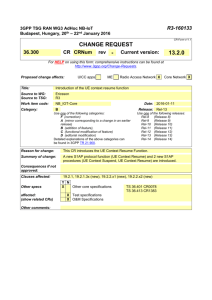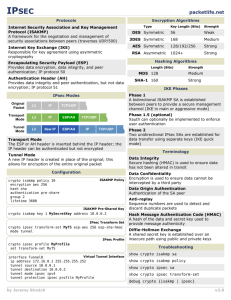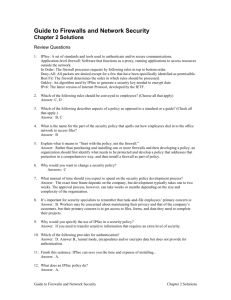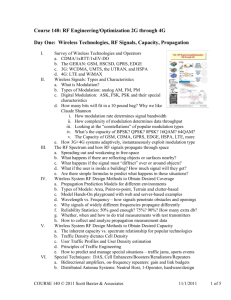Y. LTE-WLAN RAN level integration using IPSec tunnelling
advertisement
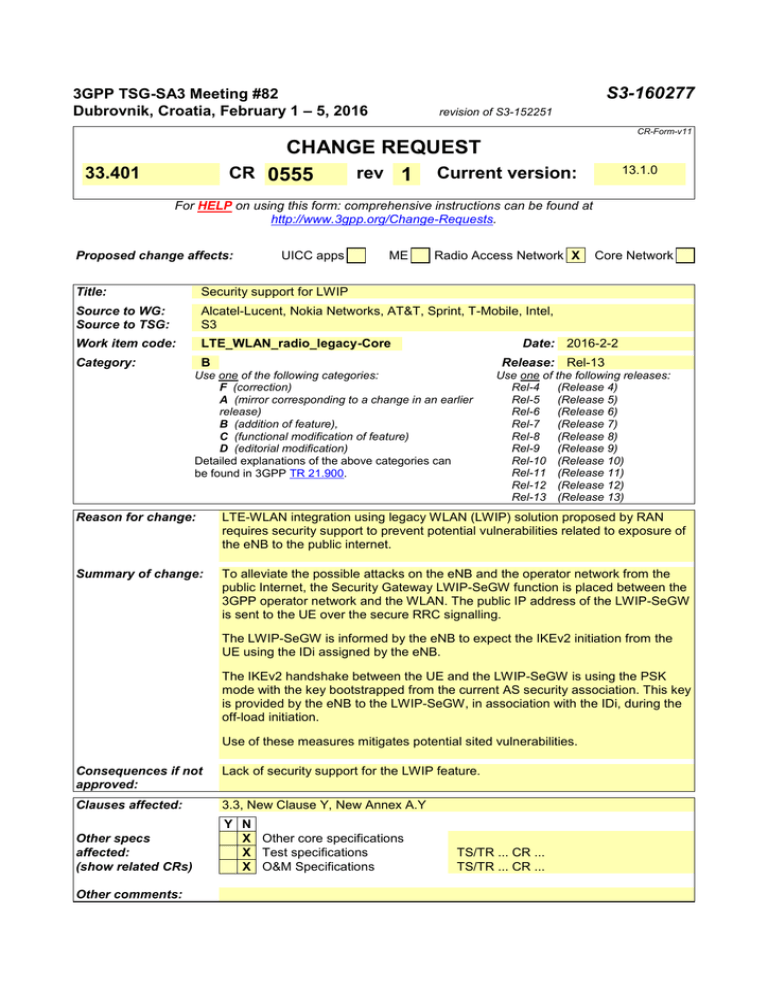
S3-160277 3GPP TSG-SA3 Meeting #82 Dubrovnik, Croatia, February 1 – 5, 2016 revision of S3-152251 CR-Form-v11 CHANGE REQUEST CR 0555 rev 1 Current version: 33.401 13.1.0 For HELP on using this form: comprehensive instructions can be found at http://www.3gpp.org/Change-Requests. Proposed change affects: UICC apps ME Radio Access Network X Title: Security support for LWIP Source to WG: Source to TSG: Alcatel-Lucent, Nokia Networks, AT&T, Sprint, T-Mobile, Intel, S3 Work item code: LTE_WLAN_radio_legacy-Core Date: 2016-2-2 B Category: Core Network Release: Rel-13 Use one of the following categories: F (correction) A (mirror corresponding to a change in an earlier release) B (addition of feature), C (functional modification of feature) D (editorial modification) Detailed explanations of the above categories can be found in 3GPP TR 21.900. Use one of the following releases: Rel-4 (Release 4) Rel-5 (Release 5) Rel-6 (Release 6) Rel-7 (Release 7) Rel-8 (Release 8) Rel-9 (Release 9) Rel-10 (Release 10) Rel-11 (Release 11) Rel-12 (Release 12) Rel-13 (Release 13) Reason for change: LTE-WLAN integration using legacy WLAN (LWIP) solution proposed by RAN requires security support to prevent potential vulnerabilities related to exposure of the eNB to the public internet. Summary of change: To alleviate the possible attacks on the eNB and the operator network from the public Internet, the Security Gateway LWIP-SeGW function is placed between the 3GPP operator network and the WLAN. The public IP address of the LWIP-SeGW is sent to the UE over the secure RRC signalling. The LWIP-SeGW is informed by the eNB to expect the IKEv2 initiation from the UE using the IDi assigned by the eNB. The IKEv2 handshake between the UE and the LWIP-SeGW is using the PSK mode with the key bootstrapped from the current AS security association. This key is provided by the eNB to the LWIP-SeGW, in association with the IDi, during the off-load initiation. Use of these measures mitigates potential sited vulnerabilities. Consequences if not approved: Lack of security support for the LWIP feature. Clauses affected: 3.3, New Clause Y, New Annex A.Y Other specs affected: (show related CRs) Y N X Other core specifications X Test specifications X O&M Specifications Other comments: TS/TR ... CR ... TS/TR ... CR ... ************************************* start of change ************************** 3.3 Abbreviations For the purposes of the present document, the abbreviations given in TR 21.905 [1] and the following apply. An abbreviation defined in the present document takes precedence over the definition of the same abbreviation, if any, in TR 21.905 [1]. AES AK AKA AMF AN AS AUTN AV ASME Cell-ID CK CKSN C-RNTI CRL DeNB DoS DSCP EARFCN-DL ECM EEA EIA eKSI EMM eNB EPC EPS EPS-AV E-UTRAN GERAN GUTI HE HFN HO HSS IK IKE IMEI IMEISV IMSI IRAT ISR KDF KSI LWIP LSB LSM MAC-I MACT ME MME MME-RN MS MSC MSIN Advanced Encryption Standard Anonymity Key Authentication and Key Agreement Authentication Management Field Access Network Access Stratum Authentication token Authentication Vector Access Security Management Entity Cell Identity as used in TS 36.331 [21] Cipher Key Cipher Key Sequence Number Cell RNTI as used in TS 36.331 [21] Certificate Revocation List Donor eNB Denial of Service Differentiated Services Code Point E-UTRA Absolute Radio Frequency Channel Number-Down Link EPS Connection Management EPS Encryption Algorithm EPS Integrity Algorithm Key Set Identifier in E-UTRAN EPS Mobility Management Evolved Node-B Evolved Packet Core Evolved Packet System EPS authentication vector Evolved UTRAN GSM EDGE Radio Access Network Globally Unique Temporary Identity Home Environment Hyper Frame Number Hand Over Home Subscriber Server Integrity Key Internet Key Exchange International Mobile Station Equipment Identity International Mobile Station Equipment Identity and Software Version number International Mobile Subscriber Identity Inter-Radio Access Technology Idle Mode Signaling Reduction Key Derivation Function Key Set Identifier LTE WLAN RAN Level Integration using IPSec Least Significant Bit Limited Service Mode Message Authentication Code for Integrity (terminology of TS36.323 [12]) Message Authentication Code T used in AES CMAC calculation Mobile Equipment Mobility Management Entity MME serving the RN Mobile Station Mobile Switching Center Mobile Station Identification Number NAS Non Access Stratum NAS-MAC Message Authentication Code for NAS for Integrity (called MAC in TS24.301 [9]) NCC Next hop Chaining Counter NH Next Hop OCSP Online Certificate Status Protocol OTA Over-The-Air (update of UICCs) PCI Physical Cell Identity as used in TS 36.331 [21] PDCP Packet Data Convergence Protocol PLMN Public Land Mobile Network PRNG Pseudo Random Number Generator PSK Pre-shared Key P-TMSI Packet- Temporary Mobile Subscriber Identity RAND RANDom number RAU Routing Area Update RN Relay Node RRC Radio Resource Control SEG Security Gateway SGSN Serving GPRS Support Node SIM Subscriber Identity Module SMC Security Mode Command SN Serving Network SN id Serving Network identity SQN Sequence Number SRB Source Route Bridge SRVCC Single Radio Voice Call Continuity S-TMSI S-Temporary Mobile Subscriber Identity TAI Tracking Area Identity TAU Tracking Area Update UE User Equipment UEA UMTS Encryption Algorithm UIA UMTS Integrity Algorithm UICC Universal Integrated Circuit Card UMTS Universal Mobile Telecommunication System UP User Plane USIM Universal Subscriber Identity Module UTRAN Universal Terrestrial Radio Access Network XRES Expected Response *************************************** end changes ******************************* *************************************** begin changes *********************** Y. LTE-WLAN RAN level integration using IPSec tunnelling Y.1 General This clause describes the security functions necessary to support LTE-WLAN integration using IPSec tunnelling as described in TS 36.300 [30]. The LTE-WLAN integration architecture is shown in Figure Y.1-1. S1- MME S1-U Private IP@ Public IP@ eNB WLAN LWIPSeGW RRC RRC PDCP PDCP RLC RLC MAC MAC PHY PHY NAS User plane UE-specific IPSec UE Figure Y.1-1 LTE-WLAN integration architecture using IPSec tunnelling For LTE-WLAN integration using IPSec tunnelling the integration happens using PDCP SDUs above the PDCP layer. The eNB controls activation of the integration based on the UE connectivity with a specific WLAN. Once the integration is activated, the eNB segregates incoming DL packets towards the UE for offloading via the WLAN at a layer above PDCP. The UL packets from the UE are aggregated by the eNB at the same logical point. Since PDCP security is bypassed for the data routed through the WLAN and security of the legacy WLAN is not assumed, security for the PDCP SDUs and protection of the operator network shall be achieved in the following way: - A LWIP-SeGW shall be placed between the eNB and the WLAN network for security of packets that traverse WLAN and to protect the Operator’s network. - The interface between the eNB and the LWIP-SeGW shall be confidentiality and integrity protected by NDS/IP TS 33.210 [xx]. - An UE-specific IPsec tunnel shall be established between the UE and the public IP port of the LWIP-SeGW. - In addition to terminating IPsec from the UE, the LWIP-SeGW shall perform rate limitation for DoS protection on the eNB and its backhaul links. - UEs, including authenticated and authorized UEs using LWIP, shall not have IP connectivity to the eNB. - The UE and the LWIP-SeGW function shall perform mutual authentication in the phase 2 of the IKEv2 handshake during the IPsec tunnel establishment, using the authentication key derived from the current AS security association. In addition, before the IPsec tunnel is established between the UE and the LWIP-SeGW, and before the offload can be performed, the UE needs to obtain IP connectivity across the WLAN network, which may require an access authentication independent of the EPC authentication, and is outside the scope of this specification. Y.2 Security of LTE-WLAN integration using IPSec Tunnelling Y.2.1 eNB to UE interaction for setting up the LWIP offload When the eNB initially establishes LWIP with the UE, the eNB and the UE shall generate the LWIP security key, LWIP-PSK, as specified in clause Y.4, to be used as the PSK for the IPSec tunnel set up between the UE and the LWIPSeGW, as described in clause Y.2.2. The eNB shall provide to the UE, over the secure RRC signalling, the following parameters: IP address of the LWIP-SeGW for the IKEv2 handshake, The Initiator Identity value, IDi, that the UE shall use in the IKEv2 handshake. Y.2.2 UE to LWIP-SeGW interaction for setting up the LWIP offload. LTE-WLAN integration (LWIP) over legacy WLAN is secured using an IPSec in a tunnel mode established between the UE, via the WLAN, and the LWIP-SeGW function. The IPSec in tunnel mode is established using the IKEv2 handshake based on the pre-shared key, PSK [Ref. IETF RFC7296]. The UE and LWIP-SeGW shall use the LWIP-PSK as the PSK for authentication in the second phase of IKEv2. When conducting the IKEv2 handshake, the UE shall use the value of IDi and the IP address of the LWIP-SeGW received from the eNB. The LWIP-SeGW shall use the received value of IDi to locate the corresponding LWIP-PSK. Note: To improve the DoS protection of the public IP port of the LWIP-SeGW, the LWIP-SeGW function may expect initiation of the IKEv2 handshake from the UE for a limited time window, based on a configuration. After expiration of this window, the LWIP-SeGW function may delete the LWIP-PSK and associated IDi, and reject any IKEv2 handshake initiations. After successful completion of the IKEv2 handshake, the LWIP-SeGW and the UE shall delete the LWIP-PSK. For LWIP offloaded traffic, the eNB shall only be reachable through the LWIP-SeGW. The LWIP-SEGW shall allow communication of the UE only to the eNB that initiated the LWIP offload, and only to the interface on this eNB allowed for the LWIP offload. The profiles for IKEv2 and IPsec ESP as defined in TS 33.310 [ref] shall be used. Y.2.3 eNB to LWIP-SeGW interaction for setting the LWIP offload The PDCP SDUs between the eNB and LWIP SeGW shall be encapsulated in a tunnelling protocol in order to avoid that the eNB needs to interpret IP packets coming from the UE. The eNB shall inform the LWIP-SeGW function of the expected initiation of IKEv2 handshake by a UE, for subsequent establishment of the IPsec, and provide the following parameters: the Initiator ID value, (IDi) that the UE will use in the IKEv2 handshake, the LWIP-PSK. The standardized interface between the eNB and the LWIP-SeGW shall be confidentiality and integrity protected by NDS/IP TS 33.210 [xx]. Y.3 Addition and modification of DRB in LTEWLAN integration All DRBs associated with the same UE and routed through WLAN shall use the same IPSec tunnel established between the UE and the LWIP-SeGW function. The eNB manages the DRB addition and deletion as specified in TS 36.300 [30]. When the last DRB between the eNB and UE is deleted, the eNB shall instruct the LWIP-SeGW and the UE to release the IPSec tunnel. Y.4 Security Key for IKEv2 handshake Y.4.1 Security Key (LWIP-PSK) Derivation The UE and eNB shall derive the security key LWIP-PSK for the IPSec tunnel set up as shown on the Fig.Y.4.1-1 and defined in Annex A.Y of the present specification. eNB/UE KDF KeNB Fig.Y.4.1-1 Y.4.2 256 LWIP- PSK LWIP-PSK Derivation. Security key (LWIP-PSK) update The eNB may update the LWIP-PSK for any reason. If the eNB refreshes its AS security context, the eNB shall instruct the LWIP-SeGW function to release the current IPSec tunnel, and provide a new LWIP-PSK derived from the new KeNB to support establishment of the new IPSec. The eNB shall instruct the UE over the RRC signaling to re-initiate the IKEv2 using the new LWIP-PSK to establish a new IPSec tunnel. Y. 5 Handover procedures During S1 and X2 handover, the IPSec tunnel between the UE and the LWIP-SeGW shall be released. The eNB shall instruct the LWIP-SeGW and the UE to release the IPSec. Both the LWIP-SeGW and the UE shall delete the LWIPPSK. Y. 6 LWIP radio link failure When a LTE radio link failure is detected, the IPSec tunnel between the UE and the LWIP SeGW shall be released, either by the eNB informing the LWIP-SeGW of this event, or at the UE. If the IPSec tunnel between the UE and the LWIP-SeGW is released due to WLAN connectivity issues, a fresh LWIP IPSec tunnel set up may be performed when WLAN wireless connectivity is restored. ********************************************* End of change ************************************************* start of change ************ A.Y Derivation of LWIP-PSK This input string is used when the eNB and UE derive LWIP-PSK from KeNB during LTE WLAN integration using IPSec. The following input parameters shall be used: - FC = 0x1D - P0 = “LWIP” (i.e. 0x4c 0x57 0x49 0x50) - L0 = 4 octets, (i.e 0x00 0x04). The input key shall be KeNB of the eNB. *************************************** end changes *******************************



